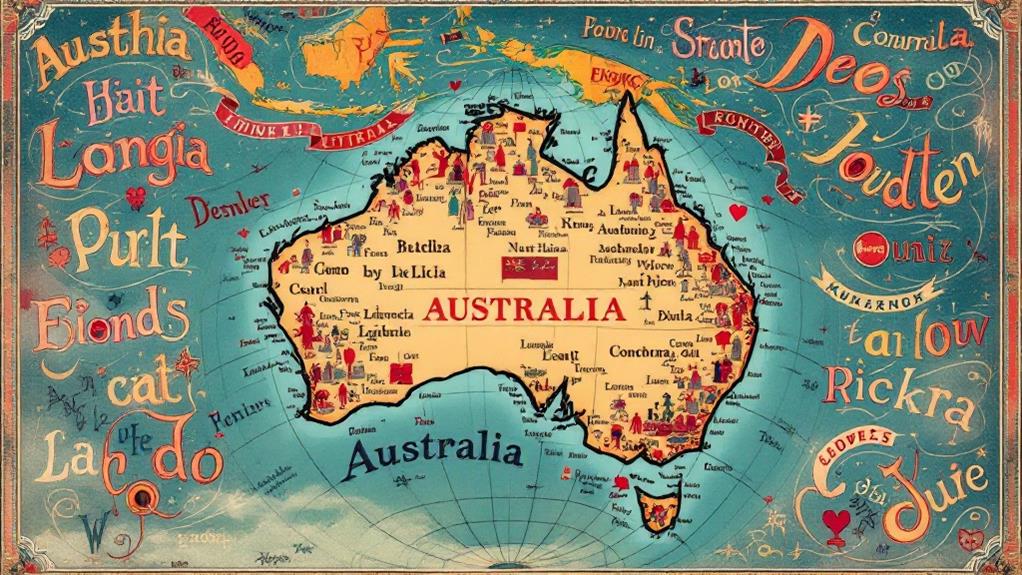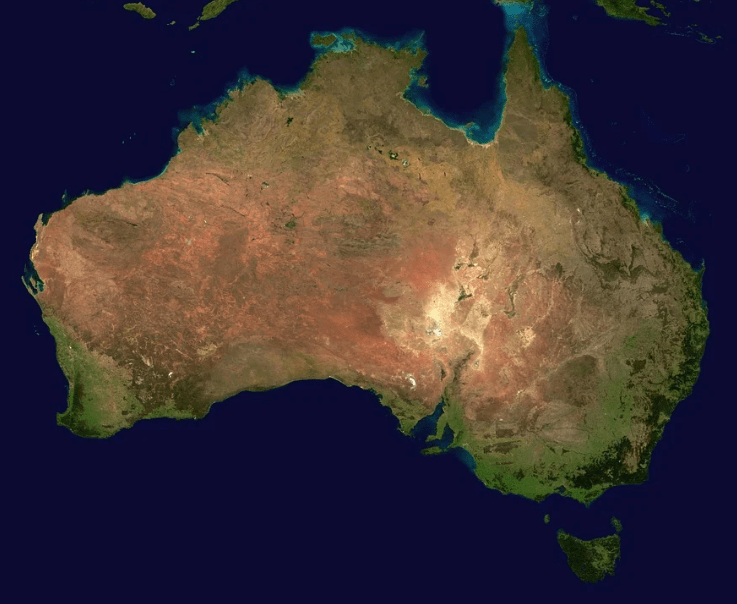Why Is Australia Called the Land Down Under? The Origins of the Nickname

You'll realize that Australia is called the "Land Down Under" because it's entirely below the equator in the Southern Hemisphere. This geographic location provides Australia with opposite seasons compared to the Northern Hemisphere, showcasing its distinct scenery and wildlife. The nickname, popularized by the Men at Work song "Down Under," highlights Australia's adventurous spirit and exotic appeal. Historically, it stems from Australia's distant image during the colonial period and Gold Rush, sparking ideas of mystery and opportunity. As you uncover more, you'll see how this term shapes Australia's cultural identity and global image.
Defining "Down Under"
Exploring the term "Down Under" reveals its roots in Australia's geographical position in the Southern Hemisphere. This nickname emerged in the late 19th century, inspired by the country's location below the equator. When you look at a map or globe, you'll see why "Down Under" makes perfect sense for Australia. Its southern placement is visually distinct, setting it apart from the Northern Hemisphere's landmasses.
The term "Down Under" isn't just about geography; it's become a cultural icon. Thanks to the catchy 1980s hit by Men at Work, the phrase gained international recognition and became a symbol of Australian pride. Despite this global fame, you might find it surprising that Australians themselves don't use "Down Under" as much as you'd think. For them, it's more of a catchy nickname for tourists rather than a day-to-day reference.
In tourism and marketing, "Down Under" paints Australia as a unique and adventurous destination, appealing to those looking for something different. So, while you might hear "Down Under" often on your travels, remember it's more a nod to Australia's global image than a local expression.
Geographic Significance
While Australia's nickname "Down Under" highlights its geographical position, the country's location in the Southern Hemisphere carries significant implications. Positioned entirely below the equator, Australia experiences seasons opposite to those in the Northern Hemisphere, offering a unique experience for anyone visiting from the north. Summers in December and winters in July might seem unusual, but they're a direct result of Australia's Southern Hemisphere location.
Australia's geographic setting also influences its remarkable biodiversity. Surrounded by the Indian and Pacific Oceans, the continent's isolated position has led to the evolution of species found nowhere else on Earth. From the iconic kangaroo to the elusive platypus, Australia's southern landscapes and varied climates provide habitats for a wide array of unique wildlife.
Historically, the concept of Terra Australis, or "unknown southern land," played into the perception of Australia as a distant, remote place. This sense of remoteness is echoed in the term "Down Under." The name reflects the perspective of early European adventurers who ventured south of Asia in search of this mysterious land. Australia's geographic significance is, consequently, deeply intertwined with its identity as the "Land Down Under."
Historical Origins

Australia's geographic significance as the "Land Down Under" is not just a matter of location; it also ties deeply into its historical origins. The term "Down Under" emerged in the late 19th century, reflecting Australia's unique position in the Southern Hemisphere, below the equator. This phrase was popularized by European adventurers, most importantly by Matthew Flinders. He referenced Australia as Terra Australis Incognita, which translates to "unknown southern land." This name captured the mystery and allure associated with a continent that was remote and isolated from the familiar landscapes of Europe and Asia.
During the colonial period, "Down Under" became synonymous with the perception of Australia as a distant and exotic land. It wasn't just a geographical label; it was a symbol of remoteness that defined the continent's early interactions with the world. The term gained even more traction during the Gold Rush period, when many saw Australia as a land of adventure and untapped opportunity. This time solidified the nickname in the public consciousness, linking it to a sense of discovery and possibility. Over time, it evolved into a symbol of national identity, associated with pride and cultural significance.
Cultural Impact
How has the term "Down Under" become such an integral part of the Australian identity? For starters, it perfectly encapsulates the spirit of national pride and the lively cultural references associated with Australia. When you think of "Down Under," you probably envision the unique wildlife, stunning natural landscapes, and iconic landmarks like the Sydney Opera House. It's not just a nickname; it's a symbol of everything that makes Australia special.
Tourism campaigns heavily rely on this evocative term to attract visitors. By highlighting the laid-back and adventurous lifestyle, these campaigns invite you to investigate Australia's wonders. Notable events like the Tour Down Under cycling race further enhance this allure by drawing international attention and elevating local pride.
Consider these points:
- Cultural References: "Down Under" features prominently in films, literature, and television, enhancing the country's image as a must-visit destination.
- National Pride: The 1981 hit song "Down Under" by Men at Work played a crucial role in cementing this nickname as a symbol of Australian heritage.
- Tourism Campaigns: By leveraging the term, Australia differentiates itself as a unique and desirable travel destination, enticing people from around the globe.
Use in Popular Culture

The phrase "Down Under" has woven itself into the fabric of popular culture, capturing the imagination of audiences worldwide. You might initially think of the 1981 hit song "Down Under" by Men at Work, which celebrates Australia's lively culture and identity. This catchy anthem has helped embed the nickname into the global consciousness, making it synonymous with the spirited land it represents.
In films and television, "Down Under" often symbolizes adventure and the exotic allure of Australia. The BBC series "Wanted Down Under" highlights this by exploring the expeditions of families considering migration to Australia, using the nickname to emphasize the appeal of life in the Southern Hemisphere. It's a reflection of how the term encapsulates the dream of a new beginning in a land of unique opportunities.
When it comes to tourism, "Down Under" is a key marketing tool. Australia entices visitors with promises of unparalleled wildlife and breathtaking landscapes, branding itself as the "Land Down Under." Even in literature, the term surfaces in travel guides and novels, offering glimpses into Australia's distinct culture and geography. Through these mediums, "Down Under" continues to captivate and inspire curiosity about this remarkable continent.
Global Perception
Rooted in its unique position in the Southern Hemisphere, the nickname "Down Under" has shaped global perceptions of Australia. This term isn't just a casual reference; it paints an image of Australia as a land of adventure and natural beauty on the global map. The world recognizes Australia as both exotic and familiar, thanks in part to its laid-back lifestyle and cultural identity. When you think of "Down Under," you're likely picturing kangaroos, the Great Barrier Reef, and the iconic Sydney Opera House.
The global perception of Australia includes:
- Cultural Identity: "Down Under" symbolizes Australia's relaxed and adventurous spirit, often highlighted by its unique wildlife and landscapes.
- Media Influence: Songs like "Down Under" by Men at Work have reinforced Australia's distinct image, making it a destination that's both intriguing and inviting.
- Tourism Appeal: International branding capitalizes on the nickname, enticing tourists with promises of stunning landmarks and unforgettable experiences.
Australia is still viewed through this lens of intrigue and wonder, largely due to how "Down Under" has been utilized worldwide. This reference to Australia has transcended mere geography, becoming a powerful symbol of what the country represents on the global stage.
Tourism and Branding

Australia's tourism industry thrives on the allure of its "Down Under" branding, a phrase that instantly evokes adventure and uniqueness. This powerful term is more than just a catchy nickname; it's a strategic tool used to draw international visitors. When you hear "Down Under," you might picture the rugged Outback, lively coral reefs, or the iconic Sydney Opera House. These images fuel your sense of adventure, enticing you to investigate the diverse landscapes and cultural experiences Australia offers.
In tourism marketing, "Down Under" is a central theme that highlights Australia's southern location and distinct identity. It's a phrase you'll find in travel literature, guiding you through the nation's diverse ecosystems. Events like the Tour Down Under cycling race are perfect examples of how the nickname is utilized to enhance tourism. They showcase local culture while capturing international attention, inviting you to participate in an Aussie adventure.
Beyond tourism, "Down Under" extends to branding Australian products and services, reinforcing their unique place in the global market. So, regardless of whether you're sampling local wines or examining the Great Barrier Reef, the "Down Under" spirit promises an unforgettable expedition.
Unique Traits of Australia
While the allure of "Down Under" fuels tourism and branding, Australia's unique traits truly set it apart on the world stage. This vast land, located in the Southern Hemisphere, is the only country that doubles as a continent. Its geographic isolation has led to the development of distinctive features of Australia, from its diverse ecosystems to its remarkable wildlife. The flora and fauna here are unlike any other, with iconic creatures like kangaroos and koalas, and an astounding 91% of the land is covered by vegetation. This coverage supports a range of environments, from arid deserts to lush tropical rainforests.
Moreover, the Great Barrier Reef, a UNESCO World Heritage site, is a proof of Australia's ecological richness. This largest coral reef system on Earth is a critical biodiversity hotspot, housing countless marine species. Australia's geological history, once part of the ancient Gondwana Supercontinent, has shaped its unique landscapes and bountiful natural resources. To truly appreciate the unique traits of this land, consider these facts:
- Biodiversity: Home to many endemic species found nowhere else.
- Ecosystems: From deserts to rainforests, it's incredibly diverse.
- Geological history: Shaped distinctive landscapes and resources.
Linguistic Nuances

When you think of Australia, the phrase "Down Under" probably comes to mind, capturing the country's unique geographical and cultural identity. This colloquial expression reflects Australia's position in the Southern Hemisphere, sitting below the equator. The term "Down Under" not only highlights Australia's geographical location but also emphasizes its distinctiveness through linguistic nuances embedded in Australian English. The expression often conveys a sense of adventure and discovery, resonating with the spirit of the nation.
The phrase gained traction in the late 19th century and became a cultural emblem, particularly when popularized by the iconic song "Down Under" by Men at Work, which celebrates national pride. In the domain of tourism and marketing, "Down Under" has become synonymous with Australia, effectively showcasing the country's laid-back lifestyle and stunning landscapes. This association has allowed the term to transcend local boundaries, earning global recognition.
Furthermore, "Down Under" appears consistently in travel literature and international branding, solidifying its role as a defining nickname for Australia. This widespread use illustrates how linguistic nuances can shape perceptions, inviting you to investigate and connect with the essence of this remarkable territory.




